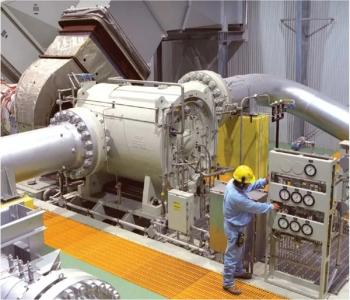
Turbo Expo Panel Sheds Light on ‘New’ Combustors, Tech Retrofits, Hydrogen Hubs
Top OEMs share progress made on new combustion systems for newly manufactured gas turbines and technology retrofits for existing fleets of gas turbines while the DOE shares updates on the regional hydrogen hubs.
ASME’s Turbo Expo 2024 in London concluded on Friday, June 28. Attendees enjoyed a packed five-day program full of technical sessions, macro-themed panel discussions, networking events, and more. Experts and insiders discussed
During Tuesday’s panel session, The Gas Turbine’s Role in the Decarbonized Power Generation Portfolio, executives, engineers, technical leaders, and managers from GE Vernova, Mitsubishi Power, Siemens Energy, and Solar Turbines discussed the challenges with production, transport, and storage of lower-carbon fuels; advancements to combustion systems; and grid support.
“All OEMs have decades of experience co-firing hydrogen with diffusion combustors,” said Carlos Koeneke, technical director at Mitsubishi Power Systems Americas. “The percentage of hydrogen has been high in cases of refinery by-product gases (in the order of 90% or higher). The current challenge is mainly related to the use of dry low NOx (DLN) combustors, where the risk of abnormal combustion, among others, associated with flashback requires testing and combustor modifications.”
Moderator Jeff Benoit, Vice President – Global Clean Energy Solutions, PSM – a Hanwha Company, broke out the “new” combustion systems into two sections:
- newly manufactured gas turbines from OEMs
- new technology retrofits for the existing fleets of gas turbines currently in operation
Retrofits
Peter Stuttaford, CEO of Thomassen Energy (TEM), a Hanwha Company, talked about the company’s FlameSheet combustion system retrofit that can be installed in most OEM’s gas turbines F-class and below. The platform offers fuel flexibility, operational range improvement, ultra-low NOx emissions, and entitlement lifecycle costs. In a gas turbine power plant—a GE Frame 7E in Daesan Korea—FlameSheet operated up to 60% hydrogen by volume.
The retrofit is offered on GE Frame 5PAs and 6Bs for 0 - 100% hydrogen, co-fired with natural gas, without diluents, in dry lean premix mode, and as a retrofit. The technology roadmap for the 7E, 7F, and 501F shows it is available up to 80% hydrogen by volume.
“For Frame 5PAs, 6Bs, and 7Es, the value proposition is using them with hydrogen carrying refinery off-gas, blue hydrogen production facilities looking to decarbonize their ‘inside the fence’ power, decarbonized industrial parks (paired with renewables), a peaking turbine for datacenter power demand, and balancing the growing variability of renewables,” Stuttaford said. “The smaller the gas turbine, in a peaking mode or where blue hydrogen production is plentiful, a significant carbon-intensity footprint reduction is possible. Peakers will likely need to be part of a hydrogen-production ecosystem, but this is where the value of ‘decarbonized, dispatchable, reliable, flexible’ peaking gas turbines settle into a sweet spot in the generation portfolio.”
Grid Support
Gas turbines are said to become “fully decarbonized, dispatchable energy sources” and support intermittent power sources. Koeneke said that in addition to gas turbines’ ability to co-fire fossil fuels with low-carbon fuels, they effectively support the grid when sudden changes in renewable production occur.
“One point that is not frequently discussed is the benefit of the fast response—not only loading up but down—to reduce curtailment of existing renewables when the load demand goes down,” he said. In other words, the gas turbine’s fast response curtails wasting green energy produced from solar, wind, and other clean sources.
Hydrogen and Ammonia
The transport, production, and storage of lower-carbon fuels have historically presented many challenges. Robert Schrecengost—Division Director of H2 with Carbon Management at the U.S. Department of Energy’s (DOE) Fossil Energy & Carbon Management—said overall advancement in terms of hydrogen production has been made with electrolyzers, “but storing and/or transportation to the site is a major investment that will be regionally focused,” he said. “Hydrogen hubs should start many of these in motion, but the Gulf region in the United States has the most hydrogen pipelines installed. Repurposing natural gas pipelines is being discussed in various locations but going to 100% hydrogen will still be a hurdle. A typical F-class gas turbine needs roughly 20K kg per hour of hydrogen. Pipelines or massive production and storage on-site will be necessary.”
In the Southwest, the LAWDP project in Utah is said to be the world's largest hydrogen-fueled generating station. The two combined-cycle blocks are in the final stages of construction and are scheduled to start 30% hydrogen cofiring in 2025 and aim for 100% hydrogen by 2045.
According to Koeneke, “the appetite” to produce, store, and co-fire low-carbon fuels is higher in regions of the world where fossil fuels are expensive. “In Asia, for example, most countries import LNG, which is not only more expensive than natural gas in terms of production, but shipping it usually involves long distances across oceans. These circumstances make hydrogen production economically reasonable in the affected countries.”
He said the long transport distances have created an additional incentive to use ammonia as a hydrogen carrier, as it does not require maintaining hydrogen at low temperatures.
“One new trend is co-firing ammonia directly instead of converting it back to hydrogen through the use of cracking,” Koeneke noted. “Several tests are currently being conducted to burn ammonia in conventional boilers and directly in gas turbines.”
Hydrogen Hubs
As previously reported, on June 12, 2024, the
At the panel, the DOE gave an overview of its Clean Energy and Strategy, Regional Clean Hydrogen Hubs Program, carbon capture and storage cycles, and pending funding announcements. The DOE’s goal is to: “build regional clean H2Hubs across the country to create networks of clean hydrogen producers, consumers, and local connective infrastructure to accelerate use of clean hydrogen.”
The Hub awards are still in negotiation between the entities and the DOE, but in October 2023, the DOE announced seven projects selected for award negotiations: Pacific Northwest, California, Heartland, Gulf Coast, Midwest, Appalachian, and Mid-Atlantic.
Chris Green, who leads the Pacific Northwest Hydrogen Hub, presented in Spokane, WA at the Renewable Hydrogen Alliance Hydrogen event. There, he shared eight potential project locations and said that engagement with local communities, Tribal leaders, and other stakeholders has begun.
In terms of timelines, Benoit argues that while hub negotiations continue, “in some cases, there are many ‘cooks in the kitchen’ and a timeline will stretch to 2030 – 2032—so not fast, but these are ecosystems looking to be developed and a significant amount of private capital is to be committed to the DOE funding of $7 billion.” Although $1 billion is set aside for the H2DI mentioned above. “This is imperative to create the demand-incentive contours to support offtake business cases, and I argue they must be made in conjunction with the DOE funding catalyst of the Hub hydrogen production side of the equation,” Benoit said.
Read more insights from this
Newsletter
Power your knowledge with the latest in turbine technology, engineering advances, and energy solutions—subscribe to Turbomachinery International today.




